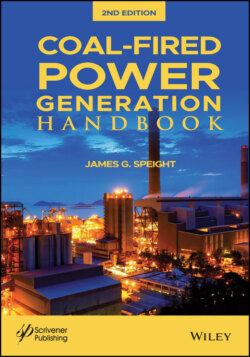Читать книгу Coal-Fired Power Generation Handbook - James Speight G., James G. Speight - Страница 50
3.2.1 Surface Mining
ОглавлениеSurface mining is the application of coal removal methods to reserves that are too shallow to be developed by other mining methods (i) the open pit method and (ii) the drift mine method. Relatively shallow coal deposits are generally extracted by surface mining, and deeper deposits are extracted by underground mining. There are also situations in which a seam is mined by surface methods first, and then if adequate reserves are still available, the mine is developed for underground extraction. Where remaining reserves are limited, other methods of mining—such as auger mining or highwall mining—may be used.
Surface mining developed as a natural extension of the early mining techniques by which man recovered coal from a seam. In the early stages, the recovered coal would come from exposed ledges or outcrops. In time, this supply would be exhausted and the earth would be scraped away to lay bare more of the seams that led to these outcroppings, thereby exposing even larger amounts of coal. However, as the overburden to be removed became too much for the primitive equipment then in use, the workings would be abandoned and fresh outcrops sought.
Typically, seams relatively close to the surface, at depths less than approximately 200 feet, are surface mined. Coal that occurs at depths of 200 to 300 feet is usually deep mined but, in some cases, surface mining techniques can be used. For example, some coal in the western United States (such as coal in the Powder River basin of Wyoming) that occur at depths in excess of 200 feet are mined by open pit methods – the thickness of the seam (60 to 90 feet) renders the method economically feasible.
In surface mining, or strip mining, earth-moving equipment is used to remove the rocky overburden and then huge mechanical shovels scoop coal up from the underlying deposit (Speight, 2013). The modern coal industry has developed some of the largest industrial equipment ever made, including shovels (part of a piece of equipment known as a dragline) capable of holding in excess of 300 tons of coal.
To reach the coal, bulldozers clear the vegetation and soil. Depending on the hardness and depth of the exposed sedimentary rocks, these rocky layers may be shattered with explosives. To do this, workers drill blast holes into the overlying sedimentary rock, fill these holes with explosives, and then blast the overburden to fracture the rock. Once the broken rock is removed, coal is shoveled from the underlying deposit into giant earth-moving trucks for transport.
The characteristic that distinguishes open pit mining is the thickness of the coal seam insofar as it is virtually impossible to backfill the immediate mined out area with the original overburden when extremely thick seams of coal are involved. Thus, the coal is removed either by taking the entire seam down to the seam basement (i.e., floor of the mine) or by benching (the staged mining of the coal seam). Frequent use is made of a drift mine in which a horizontal seam of coal outcrops to the surface in the side of a hill or mountain, and the opening into the mine can be made directly into the coal seam. This type of mine is generally the easiest and most economical to open because excavation through rock is not necessary.
Another surface mine is a slope mine in which an inclined opening is used to trap the coal seam (or seams). A slope mine may follow the coal seam if the seam is inclined and outcrops, or the slope may be driven through rock strata overlying the coal to reach a seam that is below drainage. Coal transportation from a slope mine can be by conveyor or by track haulage (using a trolley locomotive if the grade is not severe) or by pulling mine cars up the slope using an electric hoist and steel rope if the grade is steep. The most common practice is to use a belt conveyor where grades do not exceed 18°. On the other hand contour mining prevails in mountainous and hilly terrain, taking its name from the method in which the equipment follows the contours of the earth.
Auger mining is frequently employed in open pit mines where the thickness of the overburden at the high-wall section of the mine is too great for further economic mining. This, however, should not detract from the overall concept and utility of auger mining as it is also applicable to underground operations. As the coal is discharged from the auger spiral, it is collected for transportation to the coal preparation plant or to the market. Additional auger lengths are added as the cutting head of the auger penetrates further under the high wall into the coal. Penetration continues until the cutting head drifts into the top or bottom, as determined by the cuttings returned, into a previous hole, or until the maximum torque or the auger is reached.
In general, surface mining has many advantages compared to underground mining. In general, coal recovery is high (85 to 90%+ w/w of the available coal), compared to 40 to 70% w/w of the available coal in underground seams. Also, health and safety statistics for surface mining are also generally better than those of underground mining. Surface-mined coal from the Powder River Basin (Wyoming) is usually simply sized and screened in preparation for market, whereas underground-mined coal and surface-mined coal from the Interior and Appalachian basins often requires a greater amount of processing (see below) to improve its marketability. The cost per ton of mining coal by surface methods is generally lower than that by underground methods.
